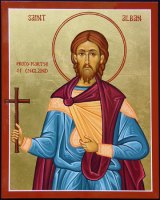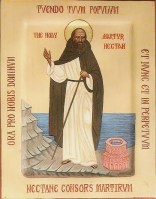icon image from
WSIP; image by the hand of E. Bakalarz
Today (23 June) we commemorate St. Etheldreda (Audrey, AEthelthryth), foundress of Ely Abbey, Virgin (679). From Miss Dunbar:
St. Ethelreda, June 23 (Edeldrud, Elidru, Etheldreda, Aetheldryth, Edilthryda, Etheldrita, Ediltrude, Audrey, Awdry). 636-679. Queen of Northumbria. First Abbess of Ely. Daughter of Anna, king of the East Angles (635-654). Represented with the emblems of royalty, and of her rank as abbess, sometimes with a book, and sometimes a crown of flowers, or crowned, with a crosier and budding staff. At Ely Cathedral, lantern columns represent her asleep, her head in a nun’s lap, a book in her hand, with a tree blossoming above her. Anna was of the family of the Uffings, descendants of Odin. He was a Christian, and did much for the conversion of his own kingdom, and that of Wessex, his chief enemy being the savage Penda, heathen king of Mercia.
St. Ethelreda was the third daughter of Anna, by his wife St.Hereswitha, though some authorities say that St. Hereswitha was married to Ethelhere, Anna’s brother. Anna’s family of daughters were famous for their piety, namely, St Ethelburga, St Sexburga, St Etheldreda and St Withburga. Ethelreda was born at Exning, or Erming, in Suffolk, and was brought up in an atmosphere of piety. It was her ambition to be a nun like her sisters, but she was destined not to attain this goal until she had been twice married. In 652, she was given against her will to Tombert, or Tondbrecht, prince or ealdorman of the Girvii, an East Anglian people settled in a place that now forms part of Cambridgeshire, Huntingdonshire, and Lincolnshire. Tombert gave his wife as a settlement an estate then called Elge, and afterwards Ely. Tombert, either respecting and sympathizing with her monastic vocation, or regarding her with indifference, allowed her to live as a nun during the three years of their marriage. During that time occurred (in 654) the defeat and death of King Anna by Penda, and he was succeeded by his brother Ethelhere.
After the deaths of her husband and father, Ethelreda settled on her own estate of Ely, intending to spend the rest of her life in religious retirement. But in 600, for family reasons, probably to secure for the house of the Uffings the alliance of the powerful kingdom of Northumbria, against the aggressions of
the Mercians, she married Egfrid, second son of Oswy, king of Northumbria, by ST. EANFLEDA, daughter of Edwin and ST. ETHELBURGA.
At the time of his marriage, Egfrid was little more than a child. Ethelreda won his esteem and affection at once, and rapidly acquired a purifying and ennobling influence over him. He “held her as a thing enskied and sainted;” he sat at her feet, and learnt wisdom and self-denial from her, and he assisted her in her good works.
While Ethelreda was queen of Northumbria, she delighted in the society of monks and nuns, and took care to invite and attract to her house such of them as were most distinguished for learning and piety. Among these was St. Cuthbert, the young prior of Lindisfarne. She bestowed many gifts from her private property on his monastery, and desiring to give him also a token of her regard for himself, and to be specially remembered in his prayers, she made and embroidered with her own skilful fingers a stole and a maniple, that he might wear her gift only in the presence of God, and be reminded of her while offering the holy sacrifice.
In 670, at the age of twenty-four, Egfrid ascended the throne of Northumbria. Immediately the Scots and Picts, who owed him service and tribute, despising his youth, rebelled, and the pious Wulfere of Mercia, with hereditary jealousy of the neighbouring kingdom, attempted to subjugate it. Egfrid, however, reduced the northern rebels to submission, and then turned his arms against the Mercians, who, instead of annexing Northumbria, were themselves annexed by that state. Egfrid, after a time, restored the kingdom to Ethelred, the brother of Wulfere, who had married ST. OSTHRIDA, Egfrid’s sister. St. Wilfrid was the friend and adviser of the king and queen, Egfrid and Ethelreda. Ethelreda gave him the lands of Hexham which Egfrid had given her, and there Wilfrid built the fairest church that existed north of the Alps, after he had already rebuilt the Cathedral of York, and done much to improve and beautify his monastery of Ripon.
Meantime, Egfrid, who had been the humble adorer of his beautiful wife for twelve years, had arrived at the age of passions, and his affection had, grown to a love that could no longer be satisfied with worship at a distance. He had hitherto consented to let her live in his house like a nun in her convent, but now that he was a man and a king, with the pride of success in war, and with more knowledge, wealth, and power, he demanded one thing more of Fate and of Ethelreda. He entreated Wilfrid to use his influence to induce her to become in fact what as yet she had been only in name. He promised Wilfrid great things for himself and for his churches, should he be able to persuade the queen that her duty to God was her duty to her husband. Wilfrid feigned to enter into the king’s view of the matter, but, in fact, he steadfastly encouraged the queen to persist in her celibate life, and even advised her to ask permission to leave tie court and become a nun. Few persons of the present day will approve of the conduct of Wilfrid in this matter, but none of his contemporaries seem to have thought him worthy of anything but praise. Egfrid never forgave him. After many painful scenes, an unwilling consent was wrung from Egfrid, no sooner given than repented. But before he could give orders to the contrary, Ethelreda had fled to Coldingham beyond the Tweed, where ST. EBBA (1) was abbess, she was sister of the late king Oswy, and aunt of Egfrid.
Egfrid found life intolerable without Ethelreda, and determined to bring her back with or without her consent. St. Ebba heartily sympathized with Ethelreda, but seeing that should Egfrid insist reclaiming his wife resistance would be impossible, advised her to escape from Coldingham in the disguise of a beggar. Ethelreda did this, attended by two of the nuns from Coldingham, SS. SEWARA and SEWENNA. She did not go to her aunt, ST. HILDA, at Whitby, as she would have opposed anything advised by Wilfrid, but decided to go back to her own lands at Ely. Many stories are told of her adventures on the journey, and they have often been the subject of sculpture and painted glass in the English monastic churches.
On the first day of her flight, Ethelreda was all but overtaken by her husband. She arrived at a headland, Colbert’s Head, jutting into the sea, and her pious intention was protected by the tide, which at once rose to an unusual height around the rock, making the place inaccessible to her pursuers. Egfrid resolved to wait till the ebbing waters should leave the path open to him, but instead of going down in a few hours, the waters remained at high tide for seven days. The baffled pursuer then realized that a power greater than his had taken Etheldreda and her vow under His protection, so gave up the idea of compelling her to come back to him, and returned home.
Another miraculous incident is recorded of her flight. One very hot day. as she was travelling on foot, overpowered with fatigue, she stuck her staff into the ground, and lay down to rest on the open plain. When she awoke, the staff had put forth leaves and branches and it afterwards became a mighty oak tree, larger than any other for many miles around. At length, after many days of weary walking, the saint arrived on her own lands of Ely. Here there was a piece of good, firm, rich land, supporting six hundred families, and surrounded to a great distance by fens, forming a more formidable rampart than walls or plain water would have done.
Here, in 673, Ethelreda built one of those large double monasteries which were so famous and so important in the early days of the English Church. Wilfrid, who never lost sight of his old friend, made her abbess, and gave the veil to her first nuns. He obtained special privileges for her from the Pope, and often visited her, and helped her with advice and suggestions useful in the management of her large establishment. Hither came many of her friends and relations to live under her rule, or to place their daughters in her care. Hither came many holy men and priests to take her for their spiritual guide. Many of her old friends and courtiers followed her and her example. Her devoted steward, Oswin, who had been in her service from childhood, and did not care to remain in the outer world without her, recognizing his own unfitness for study and meditation, carried his spade to St. Chad at Lichfield, and begged, not for repose, but for labour. “You shall read in your cell,” said he, “and I will dig for you.”
Ethelreda ruled over her monastery for seven years, setting a great example of piety and abstinence, and all other monastic virtues. Though such a great lady, and so delicately reared, she never wore any linen, but only rough woollen clothing. She denied herself the use of the warm bath, a luxury much in use among the English in her time, only permitting herself this indulgence at the four great festivals of the year, and even then she only used the bath that had already served for the other nuns.
Among the kindred princesses who were attracted by Ethelreda’s good qualities and the fame of her holiness, was her sister, ST. SEXBURGA, queen of Kent, who, leaving her own foundation of Sheppey, came and put herself under the rule of Ethelreda, and at her death, in 679, succeeded her as abbess.
Ethelreda died of a quinsy, which she regarded as a punishment for her former love of dress, and, in particular, for having worn jewels on her neck. An incision was made in her throat by a surgeon, who afterwards swore to the healing of the wound after death.
Ethelreda is one of the most popular of English saints, and there are more dedications in her name in England than in that of any female saint of the early Anglo-Saxon Church. Her day is June 23, the anniversary of her death.
In 696, St. Sexburga had her body taken from its tomb, where it was found, not only undestroyed, but with a youthful freshness which had long departed from the face of the living Ethelreda. Many miracles were wrought at her tomb, and at those of her successors, who were princesses of the same family, and the abbey of Ely was for many years very famous and very rich. It was constituted a cathedral in 1109, the abbot and bishop being thenceforth one person.
The life and merits of Ethelreda were the favourite study of medieval writers, and many notices of her are still extant.
=*=*=
Troparion Tone VIII:
In thee the Image of God was preserved, O noble Audrey, for thou didst take up thy cross and follow Christ. Royal virgin, thou didst teach the multitude by thine example that the flesh is to be scorned as fleeting, while the soul needeth great care as immortal. Wherefore, O holy Audrey, thou dost now make glad with the angels.
Holy St Etheldreda, pray to God for us.


